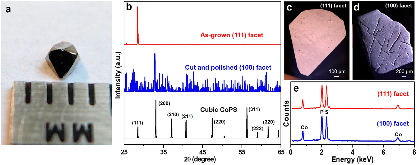Crystallographic Facet Dependence of the Hydrogen Evolution Reaction on CoPS: Theory and Experiments
- Department of Chemistry, University of Wisconsin−Madison, 1101 University Avenue, Madison, Wisconsin 53706, United States, Department of Applied Physics, Nanjing University of Science and Technology, Nanjing 210094, P. R. China
- Department of Chemistry, University of Wisconsin−Madison, 1101 University Avenue, Madison, Wisconsin 53706, United States
- Department of Applied Physics, Nanjing University of Science and Technology, Nanjing 210094, P. R. China
Cobalt phosphosulfide (CoPS) has recently emerged as a promising earth-abundant electrocatalyst for the hydrogen evolution reaction (HER). Nonetheless, the influence of crystallographic surface on the HER activity of CoPS and other nonmetallic electrocatalysts remains an important open question in the design of high-performance catalysts. Herein, the HER activities of the (100) and (111) facets of CoPS single crystals were studied using complementary experimental and computational approaches. Natural (111) and polished (100) facets of CoPS single crystals were selectively exposed to reveal that the HER behaviors on these two facets are quite different, with current density-potential curves crossing near 0.35 V vs RHE. Computational analysis can explain this phenomenon in terms of strongly differing H atom adsorption free energies and H-H recombination barriers on the facets, in conjunction with a simple kinetic model. At low potential (0-0.35 V), H adsorption (Volmer step) is rate limiting due to the endergonic adsorption on the (111) facet vs exergonic adsorption on the (100) facet, yielding a faster HER rate for the latter. However, at high potential (>0.35 V), H2 recombination/desorption becomes limiting and thus the (111) facet, with lower associated barriers, shows better HER activity. Explicit consideration of both steps and their interplay allows for a comprehensive description of the overpotential-dependence of the HER activity. This integrated study yields additional insight into the factors which govern the facet-dependence of catalytic activity on nonmetallic electrocatalysts and can further improve the design of advanced nanostructured HER catalysts.
- Research Organization:
- Univ. of Wisconsin, Madison, WI (United States)
- Sponsoring Organization:
- USDOE Office of Science (SC), Basic Energy Sciences (BES) (SC-22). Materials Sciences & Engineering Division
- Grant/Contract Number:
- FG02-09ER46664; SC0002162
- OSTI ID:
- 1416850
- Alternate ID(s):
- OSTI ID: 1508323
- Journal Information:
- ACS Catalysis, Journal Name: ACS Catalysis Vol. 8 Journal Issue: 2; ISSN 2155-5435
- Publisher:
- American Chemical Society (ACS)Copyright Statement
- Country of Publication:
- United States
- Language:
- English
Web of Science
Similar Records
Liquid-Phase Effects on Adsorption Processes in Heterogeneous Catalysis
Operando Spectroscopic Analysis of CoP Films Electrocatalyzing the Hydrogen-Evolution Reaction








